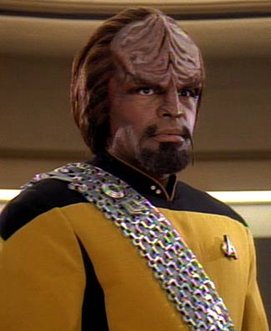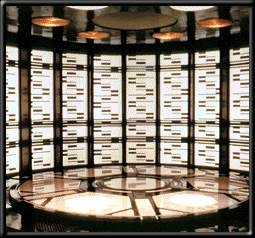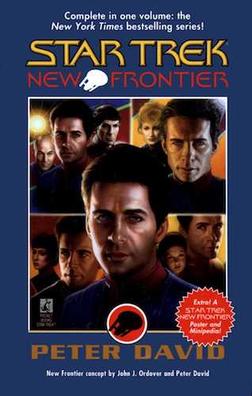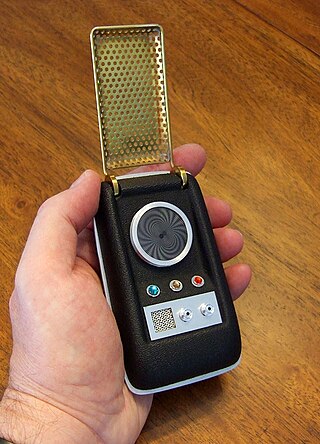Related Research Articles

Star Trek: The Next Generation (TNG) is an American science fiction television series created by Gene Roddenberry. It originally aired from September 28, 1987, to May 23, 1994, in syndication, spanning 178 episodes over seven seasons. The third series in the Star Trek franchise, it was inspired by Star Trek: The Original Series. Set in the latter third of the 24th century, when Earth is part of the United Federation of Planets, it follows the adventures of a Starfleet starship, the USS Enterprise (NCC-1701-D), in its exploration of the Alpha quadrant and Beta quadrant in the Milky Way galaxy.
Star Trek: Deep Space Nine (DS9) is an American science fiction television series created by Rick Berman and Michael Piller. The fourth series in the Star Trek media franchise, it originally aired in syndication from January 3, 1993, to June 2, 1999, spanning 176 episodes over seven seasons. Set in the 24th century, when Earth is part of a United Federation of Planets, its narrative is centered on the eponymous space station Deep Space Nine, located adjacent to a wormhole connecting Federation territory to the Gamma Quadrant on the far side of the Milky Way galaxy.

Worf, son of Mogh is a fictional character in the Star Trek franchise, portrayed by actor Michael Dorn. He appears in the television series Star Trek: The Next Generation (TNG), seasons four through seven of Star Trek: Deep Space Nine (DS9), and the third and final season of Star Trek: Picard, as well as the feature films Star Trek Generations (1994), Star Trek: First Contact (1996), Star Trek: Insurrection (1998), and Star Trek: Nemesis (2002).
In the Star Trek science-fiction franchise, the Maquis are a 24th-century paramilitary organization-terrorist group. The group is introduced in the two-part episode "The Maquis" of the television series Star Trek: Deep Space Nine, building on a plot foundation introduced in the episode "Journey's End" of Star Trek: The Next Generation, and appear in later episodes of those two series as well as Star Trek: Voyager. The Maquis story debuted when three Star Trek television shows running from 1987 to 2001 took place in the same fictional science-fiction universe at the same time in the future. As a result, the Maquis story was told across several episodes in all three shows. The Maquis are especially prominent in Star Trek: Voyager, whose premise is that a Starfleet crew and a Maquis crew are stranded together on the opposite side of the Galaxy.
Starfleet is a fictional organization in the Star Trek media franchise. Within this fictional universe, Starfleet is a uniformed space force maintained by the United Federation of Planets as the principal means for conducting deep space exploration, research, defense, peacekeeping, and diplomacy. While most of Starfleet's members are human and it has been headquartered on Earth, hundreds of other species are also represented. Most of the franchise's protagonists are Starfleet commissioned officers.

A transporter is a fictional teleportation machine used in the Star Trek universe. Transporters allow for teleportation by converting a person or object into an energy pattern, then sending ("beaming") it to a target location or else returning it to the transporter, where it is reconverted into matter ("rematerialization").
The Mirror Universe is the setting of several narratives in the Star Trek science fiction franchise, a parallel universe existing alongside, but separate from, the fictional universe that is the main setting of Star Trek. It resembles the main Star Trek universe, but is populated by more violent and opportunistic doubles of its people. The Mirror Universe has been visited in one episode of Star Trek: The Original Series, five episodes of Star Trek: Deep Space Nine, a two-part episode of Star Trek: Enterprise, a storyline woven through the first season of Star Trek: Discovery, and several non-canon Star Trek tie-in works. It is named after "Mirror, Mirror", the Original Series episode in which it first appeared.

Star Trek: New Frontier is a series of interlinked novels written by Peter David, published by Simon & Schuster imprints, Pocket Books, Pocket Star, and Gallery Books, from 1997 to 2015. New Frontier was the first Star Trek tie-in fiction property not to be based on a television series. The series was created by John J. Ordover.
This article discusses the fictional timeline of the Star Trek franchise. The franchise is primarily set in the future, ranging from the mid-22nd century to the late 24th century, with the third season of Star Trek: Discovery jumping forward to the 32nd century. However the franchise has also outlined a fictional future history of Earth prior to this, and, primarily through time travel plots, explored both past and further-future settings.

The communicator is a fictional device used for voice communication in the fictional universe of Star Trek. As seen in at least two instances, the Original Series episodes "Tomorrow Is Yesterday" and "Day of the Dove," it can also serve as an emergency signaling device/beacon, similar to a transponder. The communicator allows direct contact between individuals or via a ship's communication system.
From February 1984 through February 1996, DC Comics held the license to publish comic books based upon the Star Trek franchise, namely Star Trek: The Original Series (TOS) and Star Trek: The Next Generation (TNG).
Paramount Comics was a comic book imprint of Marvel Comics that was active for about two years beginning in 1996.
Star Trek uniforms are costumes worn by actors portraying personnel of a fictitious Starfleet in various television series and films in the Star Trek science fiction franchise. During the various series, the costume design has often changed to represent different time periods and for reasons of appearance and comfort. Sometimes different styles were deliberately mixed to enhance the sense of time travel or alternative universes.
This is a list of comics regarding the Star Trek media franchise.

Andy Mangels is an American science fiction author who has written novels, comic books, and magazine articles, and produced DVD collections, mostly focusing on media in popular culture. As an openly gay man, he has been a longtime advocate for greater visibility of gay and lesbian characters in various media, especially comics, including the coordination and moderation of the annual "Gays in Comics" panel for San Diego Comic-Con since it was begun in 1988. He is the founder of an annual "Women of Wonder Day" event, which raised over $136,000 in funds for domestic violence shelters and related programs during its seven-year run. As of 2011 he has had three books on the USA Today "best-selling books" list.
Several characters within the Star Trek franchise, primary and secondary, often made crossover appearances between one series and another. This included appearances of established characters on premiere episodes of new series, a few long-term transfers from one series to another, and even crossovers between Trek films and television. A few crossover appearances, such as that of Spock on The Next Generation and the time-travel of the crew of Deep Space Nine to the era of The Original Series were especially lauded by both fans and critics.

Star Trek is an ongoing comic book by IDW Publishing, based on characters from the Star Trek franchise, by the writers Collin Kelly and Jackson Lanzing. It is part of the Star Trek series of comics published by IDW.
References
- ↑ Bennett, Christopher L. "Star Trek: Ex Machina Annotations". Archived from the original on February 19, 2007. Retrieved December 20, 2006.
- ↑ DeCandido, Keith R.A. "Star Trek: I.K.S. Gorkon". Archived from the original on September 30, 2007. Retrieved December 20, 2006.
- 1 2 3 Ayers, Jeff (2006). Voyages of the Imagination: The Star Trek Fiction Companion. Pocket Books. ISBN 1-4165-0349-8.
- ↑ For example, the character of Commander Shelby was effectively "reserved" for the New Frontier series, and after her name was dropped in a DS9 episode, producer Ronald D. Moore "sheepish[ly ...] explained" this to Pocket and Licensing. Ronald D. Moore. "Answers". Archived from the original on October 26, 2009.
- ↑ Paul Simpson (January 2007). "The Ongoing Mission". Star Trek Magazine. Titan Magazines. p. 44.
- ↑ "Voyages Continued". Star Trek Magazine. Titan Magazines. January 2007. p. 90.
- ↑ "Shatner Still Doing Starfleet Academy Books... After Redstone Said No To A Series". The Trekmovie Report. August 8, 2006. Retrieved December 28, 2006.
- ↑ Fennell, Jack (2017). "Infinite Diversity in Infinite Combinations: The Representation of Transgender Identities in Star Trek". In Farghaly, Nadine; Bacon, Simon (eds.). To Boldly Go. McFarland & Company. pp. 76, 81. ISBN 978-1-4766-6853-6.
- ↑ Raczkowski, Felix (2012). "Von fiktiven Enzyklopädien und realen Datenbanken - die Ästhetik von Fan-Wikis". In Böhme, Stefan; Nohr, Rolf F.; Wiemer, Serjoscha (eds.). Sortieren, Sammeln, Suchen, Spielen: die Datenbank als mediale Praxis. LIT Verlag. pp. 222, 228–229. ISBN 978-3-643-11086-2.
- ↑ "Expanded Universe: Star Trek". Empire. Archived from the original on December 3, 2013. Retrieved September 20, 2022.
- ↑ "Welcome to the STAR TREK Expanded Universe!". Fandom . Retrieved September 21, 2022.
STEU is an encyclopedia and database, like Memory Alpha or Memory Beta, except for Star Trek fanworks instead of canon or licensed works.
- ↑ Curt Danhauser. "Guide to the Gold Key Star Trek Comics" . Retrieved December 25, 2006.
- ↑ Curt Danhauser. "Guide to the Gold Key Star Trek Comics" . Retrieved May 13, 2010.
- ↑ Rich Handley. "The Star Trek Comic Strips". Archived from the original on March 13, 2008. Retrieved December 25, 2006.
- ↑ "Los Angeles Times Syndicate Star Trek newspaper comic strip" . Retrieved December 25, 2006.
- ↑ "Second Star Trek monthly series from DC Comics, 1989–1996" . Retrieved December 25, 2006.
- ↑ "Star Trek: The Next Generation mini-series from DC Comics, 1998" . Retrieved December 25, 2006.
- ↑ "Star Trek: The Next Generation monthly series from DC Comics, 1989–1996" . Retrieved December 25, 2006.
- ↑ "Star Trek: Deep Space Nine monthly series from Malibu Comics, 1993–1995" . Retrieved December 25, 2006.
- ↑ "Star Trek: Deep Space Nine Celebrity Series from Malibu Comics, 1995" . Retrieved December 25, 2006.
- ↑ "Star Trek: Unlimited monthly series from Marvel Paramount Comics, 1996–1998" . Retrieved December 29, 2006.
- ↑ "Star Trek: Deep Space Nine monthly series from Marvel Comics, 1996–1998" . Retrieved December 29, 2006.
- ↑ "Star Trek: Voyager monthly series from Marvel Comics, 1996–1998" . Retrieved December 29, 2006.
- ↑ "Star Trek: Early Voyages monthly series from Marvel Comics, 1997–1998" . Retrieved December 29, 2006.
- ↑ "Star Trek: Starfleet Academy monthly series from Marvel Comics, 1996–1998" . Retrieved December 29, 2006.
- ↑ "Star Trek: Voyager – Planet Killer mini-series from Wildstorm Comics, 2001" . Retrieved December 29, 2006.
- ↑ "Star Trek: The Next Generation mini-series from Wildstorm, 2000" . Retrieved December 29, 2006.
- ↑ "Star Trek: The Next Generation mini-series from Wildstorm, 2000–2001" . Retrieved December 29, 2006.
- ↑ "Star Trek: The Next Generation graphic novels from Wildstorm, 2001–2002" . Retrieved December 29, 2006.
- ↑ "Star Trek: Deep Space Nine – N-Vector mini-series from Wildstorm, 2000" . Retrieved December 29, 2006.
- ↑ "Star Trek: Divided We Fall mini-series from Wildstorm, 2001" . Retrieved December 29, 2006.
- ↑ "This site is under construction". Store.yahoo.com. Archived from the original on February 4, 2012. Retrieved October 25, 2011.
- ↑ "TrekInk: Look Back (+ Exclusive Look Forward) At Trek Manga" (Press release). IDW Publishing. March 11, 2000. Retrieved May 15, 2010.
- ↑ "Star Trek Comics Soar Again" (Press release). IDW Publishing. November 9, 2006. Archived from the original on October 25, 2006. Retrieved December 25, 2006.
- ↑ "Star Trek Returns With All-New Comics Voyages". Spike: Asylum #4. IDW Publishing. December 2006.
- ↑ "IDW News". IDW Publishing. December 18, 2006. Archived from the original on December 23, 2006. Retrieved December 25, 2006.
- ↑ "Star Trek Adventure – Universal Studios Hollywood". the studiotour.com. Retrieved October 25, 2011.
- ↑ "de beste bron van informatie over pga thrills". pgathrills.com. Retrieved October 25, 2011.
